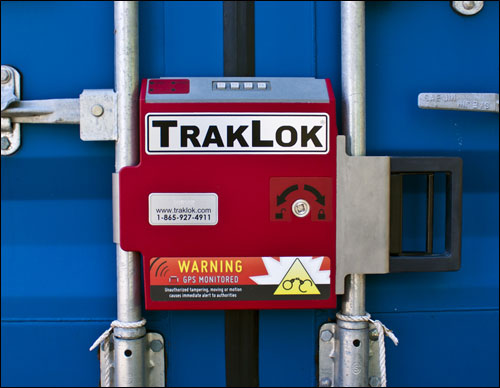Prior to launching TrakLok in 2008, the founder of that firm planned to develop an active RFID solution for tracking the location of cargo for freight companies and steamship carriers. After speaking with the potential end users, however, the company’s leadership instead opted to develop a container-locking device combining Wi-Fi-based RFID with GPS, satellite and cellular communication technologies, as well as multiple sensors. The result is the GeoLok—a system that can not only determine where a container is located at any given time, but also prevent unauthorized access to cargo by clamping onto a shipping container’s doors and keeping them locked until the proper password is entered at a predesignated location and time.
Now, with three customers employing the system and 12 pilots scheduled to take place within the next three months, the company is considering adding additional RFID functionality that will enable the tracking of items within containers, as well as the monitoring of temperature and humidity. To enable this, says Eric L. Dobson, TrakLok’s CEO and founder, the company plans to offer a firmware upgrade to the device’s built-in 2.45 GHz proprietary RFID reader, by the end of this year. However, the proprietary reader can not be used until the RFID firmware is installed.

Dobson says he gained an interest in RFID while working at previous companies (including Wireless Physics Corp. and Navigational Sciences Inc.) that were developing RFID technology for the U.S. Department of Homeland Security (DHS). He began examining commercial opportunities for the technology to track the transportation of freight, but discovered that the end users had a problem that RFID alone could not solve. “They wanted to stop loss before it happened, not just know that it was occurring,” he explains. RFID, he says, “is primarily a visibility technology.” For these end users, the concern was how to protect a container of high-value goods parked at unsecured locations along its route, or stored in a yard overnight, where video surveillance was insufficient to thwart thieves. Active RFID tags would report a possible security breach only if a container was opened, he notes, and only if there were readers present in the area to receive a tag’s transmission.
TrakLok thus built its first product, the GeoLok. “It’s a lock that only opens at the right place, at the right time, for the right person,” Dobson says. The company designed its TrakLog Web portal to manage and track shipping containers wherever they are located.
Each GeoLok comes with two locking mechanisms—one for each of a container’s two doors—as well as a keypad at the top of the device, for entering a security code (the device stores the approved security code that will prompt it to unlock the door). A second code is required to unlock the other side of the GeoLok so that it can be removed from the container. The device includes a GPS unit to calculate the container’s longitude and latitude at any given time, and sensors to detect tampering. The GeoLok comes with a radio that functions as a Wi-Fi RFID tag, enabling it transmit that sensor and GPS data, along with its unique ID number, to a Wi-Fi access point within range. It also comes with a GPRS modem for a cellular connection, and an Iridium satellite communications radio. The device first attempts transmission via a GPRS or Wi-Fi connection, before utilizing the satellite system. This, Dobson says, saves the cost of excessive use of satellite communications. The Wi-Fi RFID option makes sense only in locations in which Wi-Fi access points are installed, he explains, while the satellite and cellular functions provide visibility in nearly all other locations, with the only remaining challenge being below deck on a shipping vessel at sea.
The other unique feature of the TrakLok solution, Dobson says, is the ability for the TrakLok-hosted server software to enable geofencing. For example, when first attaching a GeoLok to a specific container, a user logs into the TrakLog software via the Internet, and inputs such information as the lock’s unique ID number and the security codes that can be accepted. The user can also specify the date, time and location in which a container can be opened, as well as the driver’s identity and the password used by that individual. If a driver were to attempt to open the container outside of those parameters, the lock would fail to open and an alert would then be sent to the TrakLog system, which could, in turn, issue an alert to the system’s authorized user.
The metal GeoLok itself is designed to be difficult to break, and to send an alert before anyone succeeds in doing so. Several built-in sensors transmit data that is used by the software to determine whether a break-in is imminent, based on a rise in temperature near the device, as well as impact to the device and vibration.
After Dobson had patented the technology, he says, a drayage company contacted TrakLok, via information it had found on a patent database, and then began trialing the technology. The GeoLok system has been in use by both that drayage firm and an international freight carrier since the first quarter of 2011. Another drayage company, C&K Trucking, has had 15 GeoLok devices in operation for approximately one month, and is now able to store containers overnight in unmanned yards thanks to the system, says Michael Burton, C&K Trucking’s president.
C&K Trucking tested a single GeoLok for about six months before purchasing 15 such devices for use on containers arriving at its 11 terminals in Chicago, as well as in other cities throughout the eastern and southern United States. The company typically attaches the device to containers housing high-value products, or to containers that must be stored overnight in yards lacking manned security. Once the containers are delivered to a customer, C&K removes the GeoLok. The system is configured to send a message to cell phones of authorized C&K managers if it detects any potential tampering of the device. To date, the system has enabled the firm to accept containers that previously may have caused a security concern (that is, if they needed to be stored in unmanned locations, or overnight). “We’re just more comfortable keeping a container in the yard now,” says Dobson, noting that the company has suffered from theft in the past, when individuals have broken into containers at night and removed products without being detected.
TrakLok’s customers can purchase GeoLoks and pay a monthly fee for access to the TrakLog portal. Dobson declines to provide the cost of the device, or the monthly fee. Once additional RFID functionality is incorporated into the GeoLok, TrakLok’s customers will be able to use the system to track not only the security and location of a container, but also the contents and conditions within that container. For example, the firm will provide RFID tags with temperature and humidity sensors that could transmit that sensor data, along with the tag’s unique ID, to the GeoLok’s built-in RFID reader. The GeoLok would then transmit that data via a cellular, Wi-Fi or satellite connection, along with location data and its own status. Initially, the company will provide active 2.4 GHz RFID tags manufactured by Telesensors, an electronic engineering design firm that helped developed the GeoLok system and was acquired by TrakLok in 2010. The tags, which employ a proprietary air-interface protocol to transmit signals that can be read by the GeoLok’s built-in RFID reader, could be attached to product cartons or pallets.
According to Dobson, some end users are requesting a passive RFID solution since passive RFID tags would be less expensive. TrakLok intends to partner with a manufacturer of passive ultrahigh-frequency (UHF) RFID hardware to provide passive EPC Gen 2 UHF tags that would be attached to items, boxes or pallets within a cargo container, as well as EPC Gen 2 readers that would transmit information via Wi-Fi to the GeoLok. In the meantime, he says, TrakLok has already tested the active 2.4 GHz RFID solution, and has found that it can transmit data effectively to the GeoLok reader from anywhere within a loaded container.
In addition, TrakLok is developing a meshing capability that will allow the GeoLok’s Wi-Fi tag to send and receive data from one lock to another within an approximately 300-foot range, and then forward that information to a Wi-Fi access point. This would ensure that users would be able to determine the device’s location and status within crowded storage areas, for example.


